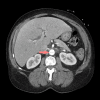Acute Aortic Dissection Presenting as Rectal Tenesmus
- PMID: 39068510
- PMCID: PMC11299886
- DOI: 10.12659/AJCR.943991
Acute Aortic Dissection Presenting as Rectal Tenesmus
Abstract
BACKGROUND Acute aortic dissection (AAD) is a life-threatening medical emergency that requires a high index of clinical suspicion to be diagnosed promptly. The variability in the clinical presentation of AAD has historically made it difficult to identify in the acute setting. There remains significant inter-physician variability in the use of imaging. The median time to diagnosis in the Emergency Department is over 4 h and AAD has a mortality rate of 68% when diagnosis is delayed by over 48 h after onset of symptoms. CASE REPORT We discuss a case of a 69-year-old woman presenting with gastrointestinal symptoms in the Emergency Department who ultimately was found to have AAD. The patient had delayed presentation by 12 h due to misattribution of her rectal tenesmus to irritable bowel syndrome. However, after a thorough history and physical exam, the Emergency Medicine physician appropriately risk-stratified the patient and correctly diagnosed her with a Stanford Type A aortic dissection using a computed tomography study of the chest, abdomen, and pelvis with intravenous contrast. CONCLUSIONS AAD is an uncommon disease often requiring emergency intervention. We summarize the research and scoring systems and discuss the physical exam findings, comorbidities, imaging modalities, and risk stratification tools. Although imperfect, the Aortic Dissection Detection Risk Score with the addition of a D-dimer test is currently the best-validated tool and should be an important part of clinical decision making prior to performing computed tomography imaging.
Conflict of interest statement
Figures
References
-
- American College of Emergency Physicians Clinical Policies Subcommittee (Writing Committee) on Thoracic Aortic Dissection. Diercks DB, Promes SB, Schuur JD, et al. Clinical policy: Critical issues in the evaluation and management of adult patients with suspected acute nontraumatic thoracic aortic dissection [published correction appears in Ann Emerg Med. 2017;70(5):758] Ann Emerg Med. 2015;65(1):32–42.e12. - PubMed
-
- Isselbacher EM, Preventza O, Hamilton Black J, et al. 2022 ACC/AHA guideline for the diagnosis and management of aortic disease: A Report of the American Heart Association/American College of Cardiology Joint Committee on Clinical Practice Guidelines. Circulation. 2022;146(24):e334–482. - PMC - PubMed
-
- Obel LM, Lindholt JS, Lasota AN, et al. Clinical characteristics, incidences, and mortality rates for type A and B aortic dissections: A nationwide Danish population-based cohort study from 1996 to 2016. Circulation. 2022;146(25):1903–17. - PubMed
-
- Evangelista A, Isselbacher EM, Bossone E, et al. Insights from the International Registry of Acute Aortic Dissection: A 20-year experience of collaborative clinical research. Circulation. 2018;137(17):1846–60. - PubMed
-
- Shiga T, Wajima Z, Apfel CC, et al. Database of abstracts of reviews of effects (DARE): Quality-assessed reviews [Internet] York (UK): Centre for Reviews and Dissemination (UK); 1995. Diagnostic accuracy of transesophageal echocardiography, helical computed tomography, and magnetic resonance imaging for suspected thoracic aortic dissection: Systematic review and meta-analysis. 2006. Available from: https://www.ncbi.nlm.nih.gov/books/NBK72807/ - PubMed
Publication types
MeSH terms
LinkOut - more resources
Full Text Sources



